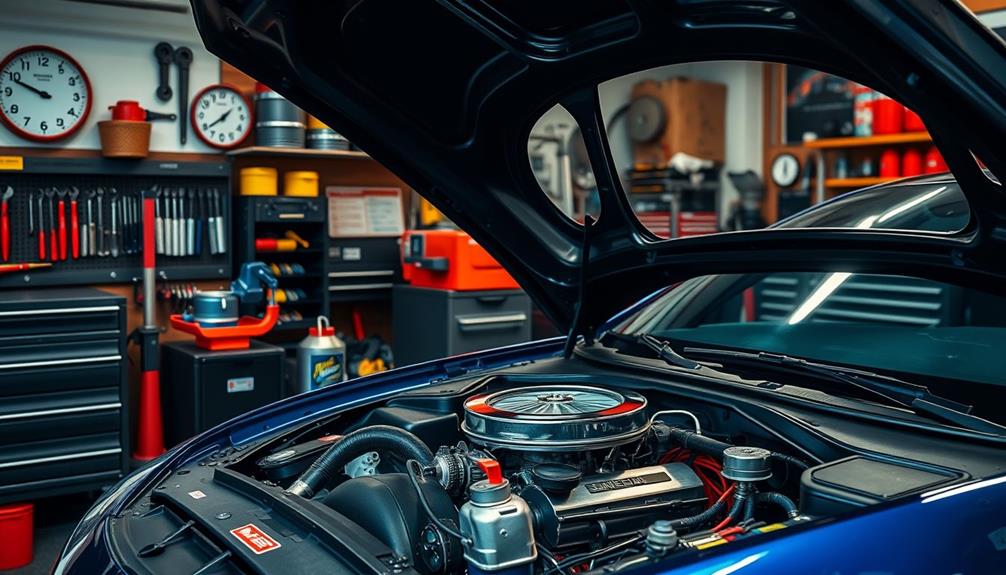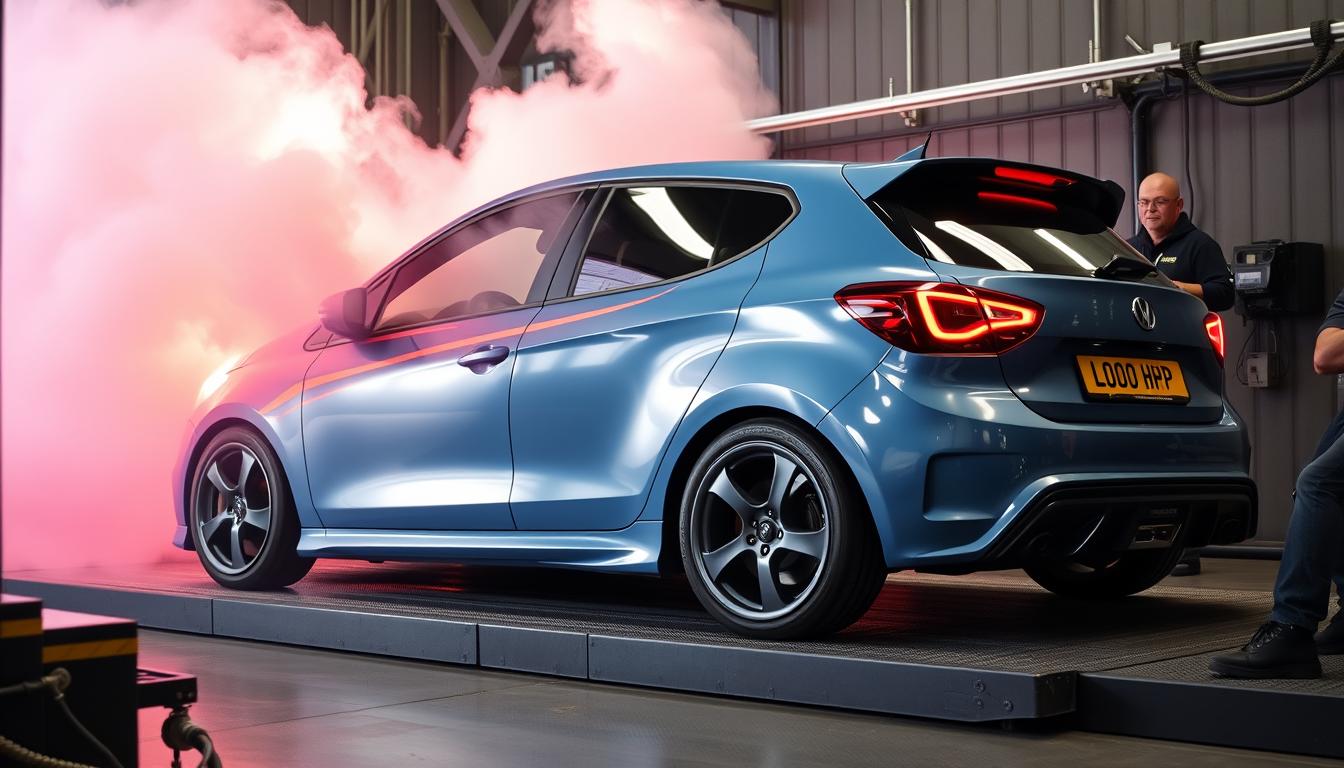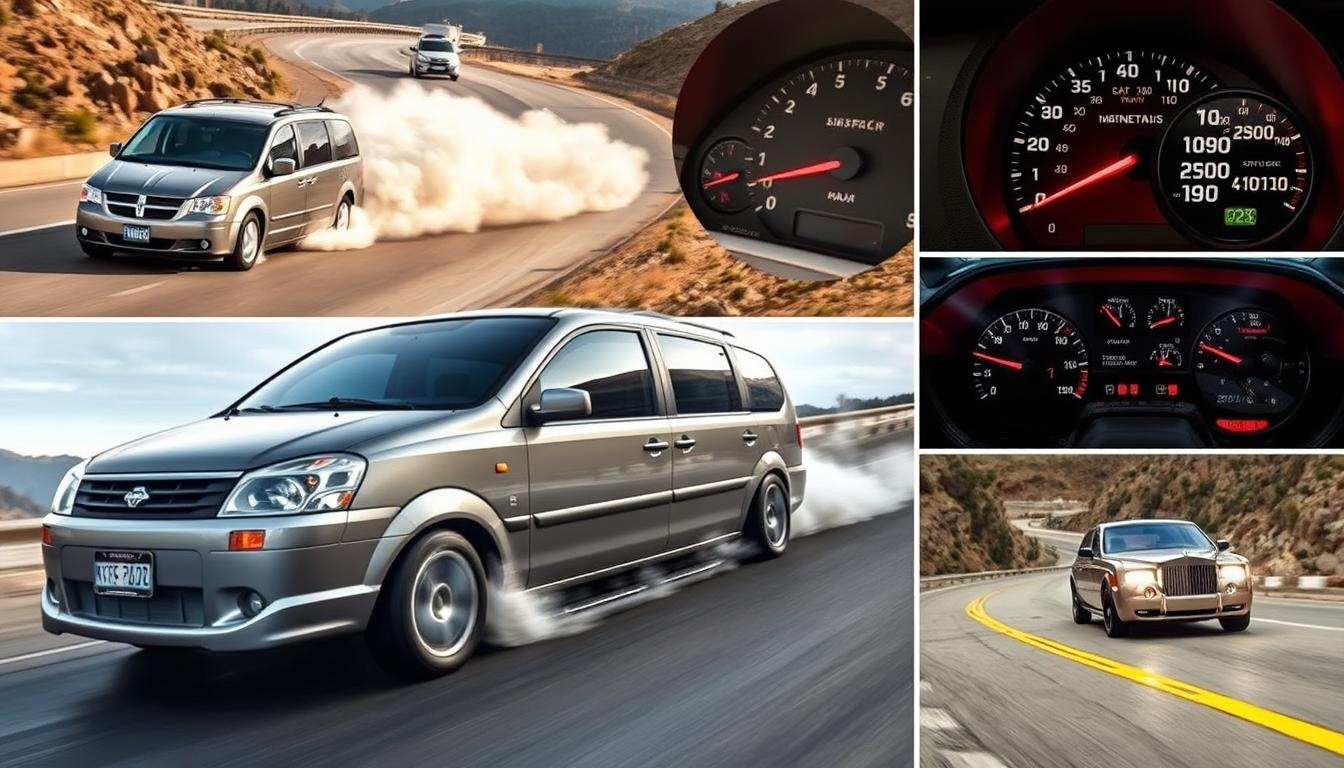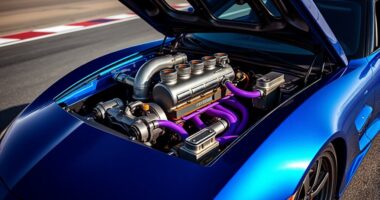Imagine you’re driving down a familiar road with the wind in your hair. Suddenly, a child runs into the street chasing a ball. Your heart races as you hit the brakes, hoping your vehicle stops in time. This shows how crucial brake upgrades are. They can mean the difference between safety and disaster. Upgrading your brakes is not just about better performance. It’s also about your peace of mind and keeping everyone safe. Not only does upgrading your brakes improve your ability to stop in emergency situations, but it also allows you to unlock more torque and power from your vehicle. This means you can accelerate and handle your car more confidently, knowing that you have superior braking power to rely on. With upgraded brakes, you can enjoy a more responsive and secure driving experience, giving you greater control and peace of mind on the road.
Let’s talk about the parts of a brake system and their roles. Each component is key to making your car stop safely and quickly. Knowing about these can help you choose the best upgrades. So, you can stop your vehicle confidently whenever you need to.
Key Takeaways
- Upgrading your brakes can significantly enhance your stopping power.
- Consider performance brakes for improved safety in emergency situations.
- The brake system comprises essential components including calipers, rotors, and pads.
- Different brake pad materials offer various benefits suited for your driving style.
- Choosing the right brake components is crucial for maintaining vehicle safety.
Understanding the Importance of Brake Upgrades
Upgrading your brakes is vital for your car’s safety and performance. It is especially important if you need your vehicle to perform better. High-performance pads, larger rotors, and better calipers are key.
Enhancing Your Vehicle’s Stopping Power
Improving your brakes can make a big difference. It means shorter stopping times, less shaking, and steady performance in tough situations. Think high speeds or bad weather.
High-performance pads handle heat well. This makes them last and stop quickly.
- Enhanced stopping distances allow for greater safety
- Reduced vibrations improve handling and comfort
- Better heat resistance promotes consistent braking performance
Ceramic and semi-metallic pads suit different driving needs. Upgrading to bigger rotors and special calipers boosts braking efficiency too.
Why Safety Should Be Your Priority
Brake safety is crucial for everyone on the road. Good brakes cut down accident risks. They make stopping quicker, response faster, and control better. This is very important for big or fast vehicles.
Check your brakes before upgrading. This ensures they’re ready for new parts and will perform well. Better brakes not only improve driving but give you peace of mind.
| Brake Upgrade Benefit | Description |
|---|---|
| Shorter Stopping Distances | Improved braking systems can stop your vehicle more quickly in emergency situations. |
| Consistent Performance | High-performance brakes maintain effectiveness under heat and stress. |
| Enhanced Control | Better braking capability allows for improved maneuvering and driving confidence. |
| Increased Safety | Reliable brakes minimize the risk of accidents and enhance driver response. |
Key Components of a Brake System
It’s key to know the main parts of a brake system for safety and power upgrades. Each part is vital for your vehicle’s brakes to work well. Let’s explore these important parts.
Brake Calipers: The Force Behind Stopping
Brake calipers create the force needed to stop your car. They press brake pads against rotors using hydraulic pressure. If you get better calipers, your stopping power could increase. But watch out for leaks or less braking power as signs of wear.
Brake Rotors: The Core of Friction
Brake rotors are crucial for braking, providing a surface for friction and heat loss. You can choose from various designs like blank, drilled, or slotted rotors. Bigger rotors can help your car stop quicker and manage heat better. This is great for improving your car’s performance.
Brake Pads: Key to Effective Braking
The brake pads are essential for good braking. They come in materials like semi-metallic, organic, and ceramic, each offering different benefits. Changing brake pads regularly keeps braking sharp. Worn-out pads might make noise and reduce how well your brakes work.
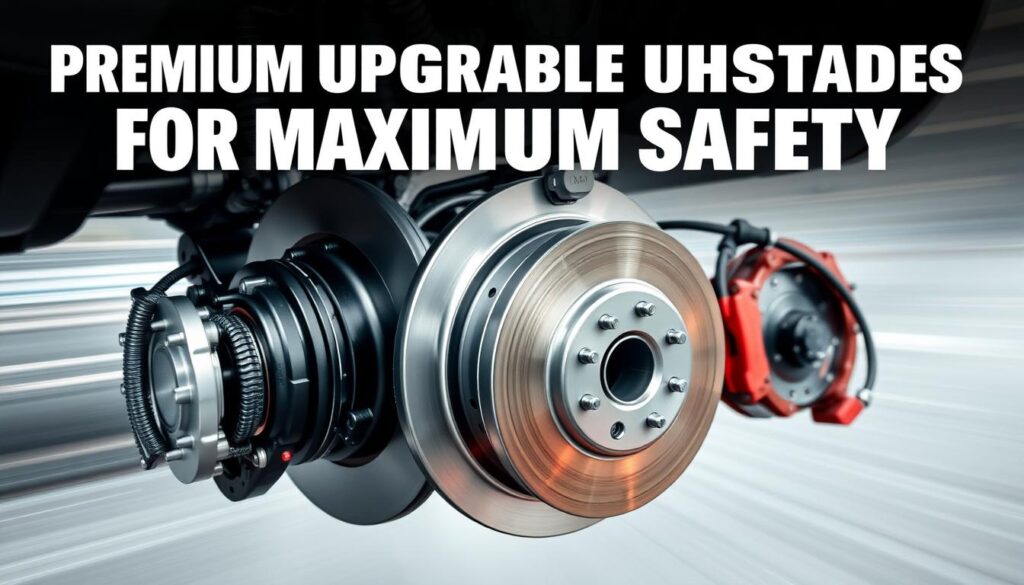
| Component | Function | Upgrade Benefit |
|---|---|---|
| Brake Calipers | Generate clamping force on pads | Increased stopping power |
| Brake Rotors | Provide friction surface and heat dissipation | Enhanced torque and heat management |
| Brake Pads | Contact rotors for stopping action | Improved friction and responsiveness |
By understanding these brake system parts, you can choose upgrades wisely. These improvements can boost your car’s performance and make roads safer.
Types of Brake Upgrades Available
Choosing the right brake upgrades depends on your needs and how you use your car. For daily drives, stock brakes work well and keep you safe in most situations. But, for racing or heavy hauling, performance brakes can improve your car’s stopping power and safety.
Performance vs. Stock Brakes
Stock brakes are enough for everyday drives but may not hold up in tough conditions. Performance brakes, on the other hand, handle extreme heat better and stop quicker. They prevent brake fade in aggressive driving, making them ideal for high-stress situations.
High-Performance Rotors and Their Benefits
Upgrading to high-performance rotors boosts your car’s braking power. These rotors cool better which helps prevent brake fading.Wilwood and Brembo are two brands that offer rotors with designs such as cross-drilled and slotted patterns. These designs not only work better but also last longer. Here’s a look at different types:
| Type of Rotor | Airflow & Heat Management | Durability | Best Use |
|---|---|---|---|
| Stock Rotors | Standard | Good | Everyday Driving |
| Cross-Drilled Rotors | Excellent | Moderate | Racing |
| Slotted Rotors | Very Good | Good | Spirited Driving |
| Two-Piece Rotors | Superior | Excellent | High-Performance Racing |
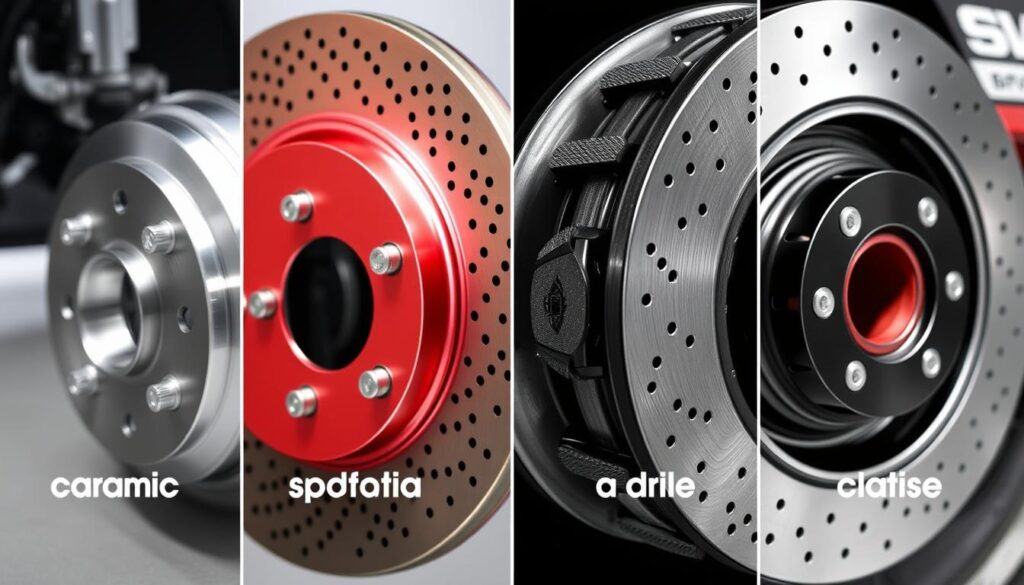
Picking the right upgrades relies on how and where you drive. Slotted rotors with better performance pads are good for street driving. Track lovers might need tougher gear like high-performance rotors and braided lines for better control. It’s smart to ask for advice on forums or from expert resources when upgrading.
Material Choices for Brake Upgrades
When upgrading brakes, material choice matters a lot. It influences both how well your brakes perform and how long they last. Picking the right brake pad materials boosts your car’s braking system and keeps you safe. It’s key to know the different options so you can choose what’s best for your drive.
Exploring Different Brake Pad Materials
There are three main types of brake pad materials:
- Semi-metallic: They perform really well because they have metal fibers. These fibers help resist heat well. But, they can make your wheels dirtier faster.
- Organic: Made from things like rubber and glass fibers. They’re quieter and great for day-to-day use. But, they might not do as well under very tough conditions.
- Ceramic: These are both clean and quiet, creating very little dust. Ceramic pads are good for different kinds of driving, offering a nice mix of performance and comfort.
The Role of Brake Hoses and Lines
The materials in brake hoses and lines are also crucial. The right choice here makes sure your brakes respond well when you need them. Here are the common materials:
- Durable rubber: A good choice for its balance of flexibility and strength.
- Braided alloy: Best for high-performance use. Braided hoses last longer and make your brakes feel more responsive.
By choosing the best materials for both brake pads and hoses, you upgrade your car’s safety and how it feels to drive.
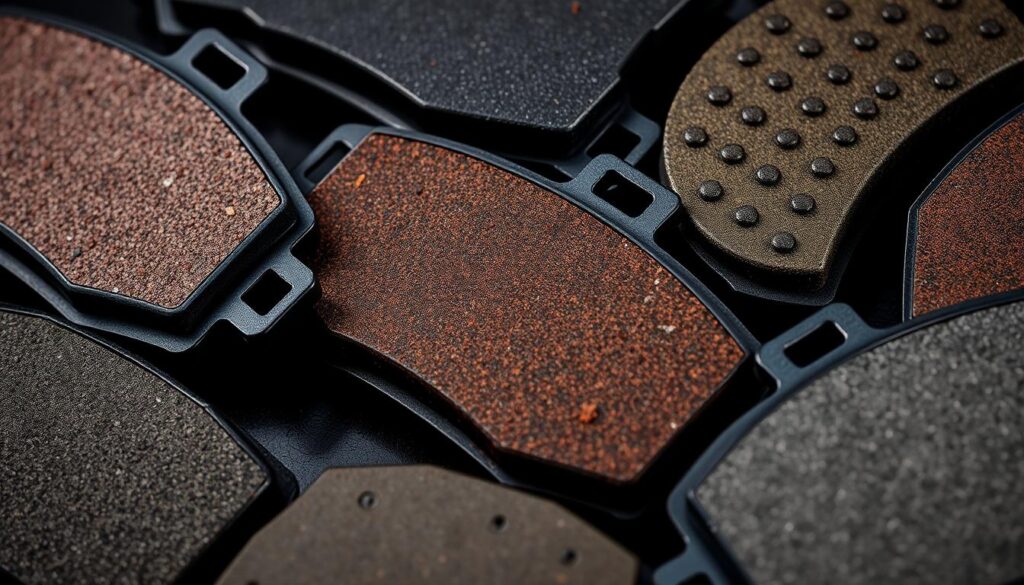
Choosing the Right Brake Components
Picking the best brake parts is crucial for your car’s safety and how well it drives. By choosing the right brake discs and pads, your vehicle stops better, lasts longer, and drives smoother.
Top Performance Brake Discs
For performance brake discs, Brembo, ATE, and Bosch are top choices. These brands make discs that stop your car quickly and resist heat. Look for the following features:
- Drilled or slotted designs for better air flow.
- High carbon content for stronger heat resistance.
- They fit a variety of cars, including fast ones.
Recommended Brake Pads for Your Vehicle
Finding the right brake pads is key to how your car stops. StopTech, Power Stop, and Akebono offer pads for different uses. Here’s what to consider:
- Material: Organic pads are quiet and smooth, while metallic ones perform better in tough situations.
- Your driving style: Choose high-performance pads for racing, but regular pads are good for everyday use.
- Heat management: Pick pads that handle heat well, especially if you brake hard a lot.
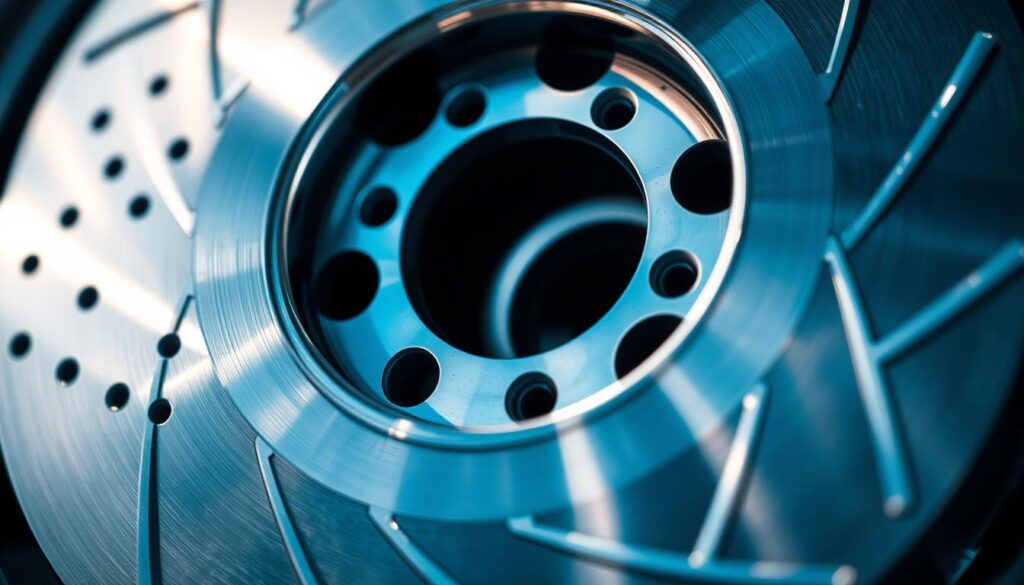
Installation and Maintenance Tips
When you think about upgrading your vehicle’s brakes, consider if you need a pro or if you can do it yourself. There are installation tips for both choices. Think about what you need and what you know to make your brakes safer and more reliable.
Professional vs. DIY Installation
Choosing a professional for brake upgrades means they will fit perfectly, which is key for safety and performance. Experts have the right tools and know-how. It costs more, but for the peace of mind and reliability, it’s often worth it.
If you prefer to upgrade your brakes by yourself, it can be rewarding and cost-efficient. Make sure you have the right installation tips and understand the process well. Always prioritize safety and know that some steps might need more skill. If it gets too tricky, it’s smart to call in a pro.
Routine Maintenance to Extend Brake Lifespan
Regular brake maintenance is key to keeping your brakes working well for longer. You should check your brakes at least once a year to spot any problems early. Focus especially on these points:
- Check the thickness of brake pads – replace them if they are under 3mm.
- Look at brake fluid levels – this should be done every two years.
- Inspect brake rotors for any grooves, cracks, or damage.
- Listen for strange sounds or feel for vibrations when you brake.
Watching for these signs helps avoid expensive fixes and keeps you safe. Neglecting them can wear out your tires unevenly and harm other brake parts. Also, breaking in new brake parts properly is important. It helps them work well from the start. Be sure to replace brake discs or drums together for even performance.
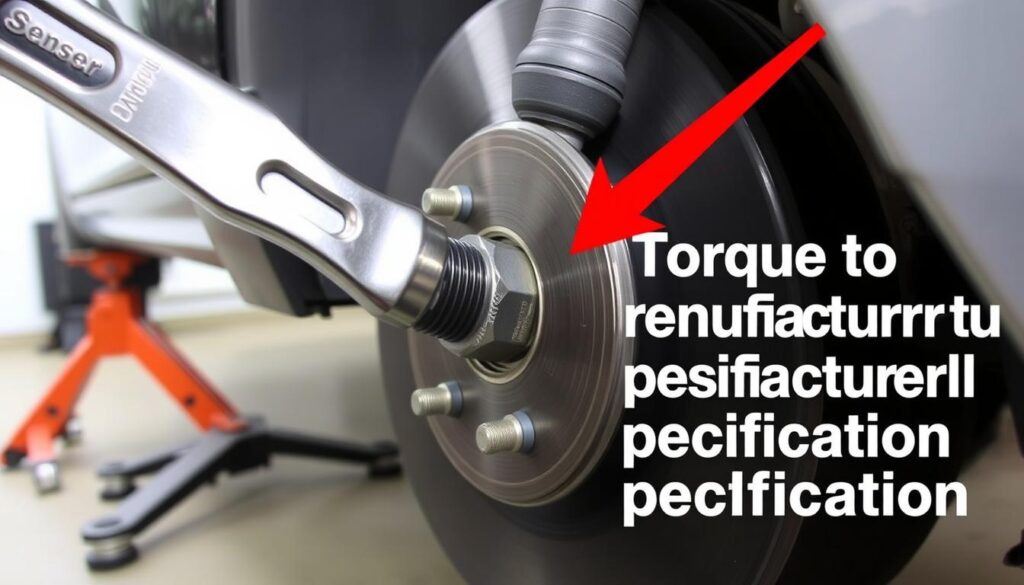
Regular brake maintenance helps your upgraded system perform its best. Paying close attention keeps you safer and more reliable on the road.
Conclusion
Upgrading your brakes is essential. It’s not just about improving; it’s about safety and performance. We’ve seen how brake upgrades can make driving better. This is true whether you’re in the city or on the track. Knowing your brake system and choosing the right parts is key.
It’s also important to keep your brakes in top shape with regular care. This will give you better stopping power. And you’ll feel more confident when you drive.
Knowing how brakes work is very important. Brake torque ratios and vehicle balance are part of this. The right upgrades help your brakes work their best. This keeps your car safe by avoiding problems like overheating.
Remember, high-performance upgrades can be really beneficial. This is especially true if safety is a big concern for your car. Keep this in mind when you’re looking at your options.
Your final thoughts should focus on brake safety. Even little adjustments can make a big difference in how your car drives. It gives you peace of mind to have great brakes. So, look at your brake parts carefully. Make good choices about upgrades. And always keep your brakes in good condition. This will keep you and your passengers safe.

